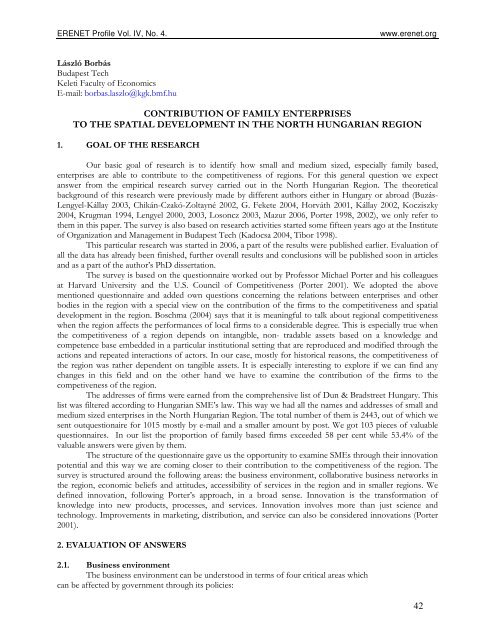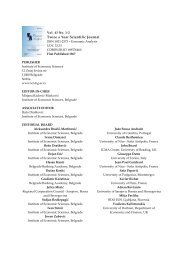Issue 16
Issue 16
Issue 16
Create successful ePaper yourself
Turn your PDF publications into a flip-book with our unique Google optimized e-Paper software.
ERENET Profile Vol. IV, No. 4.<br />
www.erenet.org<br />
László Borbás<br />
Budapest Tech<br />
Keleti Faculty of Economics<br />
E-mail: borbas.laszlo@kgk.bmf.hu<br />
CONTRIBUTION OF FAMILY ENTERPRISES<br />
TO THE SPATIAL DEVELOPMENT IN THE NORTH HUNGARIAN REGION<br />
1. GOAL OF THE RESEARCH<br />
Our basic goal of research is to identify how small and medium sized, especially family based,<br />
enterprises are able to contribute to the competitiveness of regions. For this general question we expect<br />
answer from the empirical research survey carried out in the North Hungarian Region. The theoretical<br />
background of this research were previously made by different authors either in Hungary or abroad (Buzás-<br />
Lengyel-Kállay 2003, Chikán-Czakó-Zoltayné 2002, G. Fekete 2004, Horváth 2001, Kállay 2002, Kocziszky<br />
2004, Krugman 1994, Lengyel 2000, 2003, Losoncz 2003, Mazur 2006, Porter 1998, 2002), we only refer to<br />
them in this paper. The survey is also based on research activities started some fifteen years ago at the Institute<br />
of Organization and Management in Budapest Tech (Kadocsa 2004, Tibor 1998).<br />
This particular research was started in 2006, a part of the results were published earlier. Evaluation of<br />
all the data has already been finished, further overall results and conclusions will be published soon in articles<br />
and as a part of the author’s PhD dissertation.<br />
The survey is based on the questionnaire worked out by Professor Michael Porter and his colleagues<br />
at Harvard University and the U.S. Council of Competitiveness (Porter 2001). We adopted the above<br />
mentioned questionnaire and added own questions concerning the relations between enterprises and other<br />
bodies in the region with a special view on the contribution of the firms to the competitiveness and spatial<br />
development in the region. Boschma (2004) says that it is meaningful to talk about regional competitiveness<br />
when the region affects the performances of local firms to a considerable degree. This is especially true when<br />
the competitiveness of a region depends on intangible, non- tradable assets based on a knowledge and<br />
competence base embedded in a particular institutional setting that are reproduced and modified through the<br />
actions and repeated interactions of actors. In our case, mostly for historical reasons, the competitiveness of<br />
the region was rather dependent on tangible assets. It is especially interesting to explore if we can find any<br />
changes in this field and on the other hand we have to examine the contribution of the firms to the<br />
competiveness of the region.<br />
The addresses of firms were earned from the comprehensive list of Dun & Bradstreet Hungary. This<br />
list was filtered according to Hungarian SME’s law. This way we had all the names and addresses of small and<br />
medium sized enterprises in the North Hungarian Region. The total number of them is 2443, out of which we<br />
sent outquestionaire for 1015 mostly by e-mail and a smaller amount by post. We got 103 pieces of valuable<br />
questionnaires. In our list the proportion of family based firms exceeded 58 per cent while 53.4% of the<br />
valuable answers were given by them.<br />
The structure of the questionnaire gave us the opportunity to examine SMEs through their innovation<br />
potential and this way we are coming closer to their contribution to the competitiveness of the region. The<br />
survey is structured around the following areas: the business environment, collaborative business networks in<br />
the region, economic beliefs and attitudes, accessibility of services in the region and in smaller regions. We<br />
defined innovation, following Porter’s approach, in a broad sense. Innovation is the transformation of<br />
knowledge into new products, processes, and services. Innovation involves more than just science and<br />
technology. Improvements in marketing, distribution, and service can also be considered innovations (Porter<br />
2001).<br />
2. EVALUATION OF ANSWERS<br />
2.1. Business environment<br />
The business environment can be understood in terms of four critical areas which<br />
can be affected by government through its policies:<br />
42
















